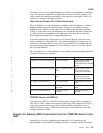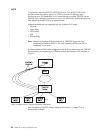With the branch extender in place the backbone network’s view of the branch
extender is as a giant end node with all the downstream LUs being owned by this
giant end node. The backbone has no knowledge of the topology downstream from
the branch extender, thus reducing the overhead of topology exchanges.
Conversely, the branch extender’s network node server, which is part of the
backbone, will have knowledge of all the LUs owned by the branch extender if the
branch extender is configured to register resources. This serves to reduce the
number and size of broadcast searches and topology updates.
An extended border node is the appropriate choice when you have multiple
networks you want to tie together, or when you have a large network you want to
subdivide without restriction on what node types are allowed in the subdivided
pieces. There is no concept of upstream or downstream and you can have
additional extended border nodes, network nodes, end nodes, DLUR, VTAM, or
VTAM end nodes located anywhere in your network. Unlike the branch extender, an
extended border node cannot register resources with another network.
Managing a Network Node
The router network node can act as an APPN entry point that forwards
APPN-related alerts to an APPN focal point. APPN focal points may be defined
explicitly or implicitly.
You can use SNMP to access these IETF standardized MIBs:
v APPC (RFC 2051)
v APPN (RFC 2155)
v HPR (RFC 2238)
v DLUR (RFC 2232)
You can also use SNMP to access these enterprise-specific MIBs:
v IBM APPN Memory
v IBM Accounting
v IBM HPR NCL
v IBM HPR Route Test
v IBM Branch Extender Node
v IBM Extended Border Node (EBN)
Entry Point Capabilities for APPN-related Alerts
The router network node can serve as an APPN entry point for alerts related to the
APPN protocol. As an entry point, the router is responsible for forwarding APPN and
LU 6.2 generic alerts about itself and the resources in its domain to a
focal point
for
centralized processing. A focal point is an entry point that provides centralized
management and control for other entry points for one or more network
management categories.
Note: If a focal point is not available to receive an alert from the device, the alert is
held (stored) by the device.
Entry points that communicate with a focal point make up that focal point’s
sphere
of control
. If a focal point explicitly defines the entry points in its sphere of control
and initiates communication with those entry points, it is an
explicit focal point
.Ifa
APPN
Chapter 1. APPN 17


















